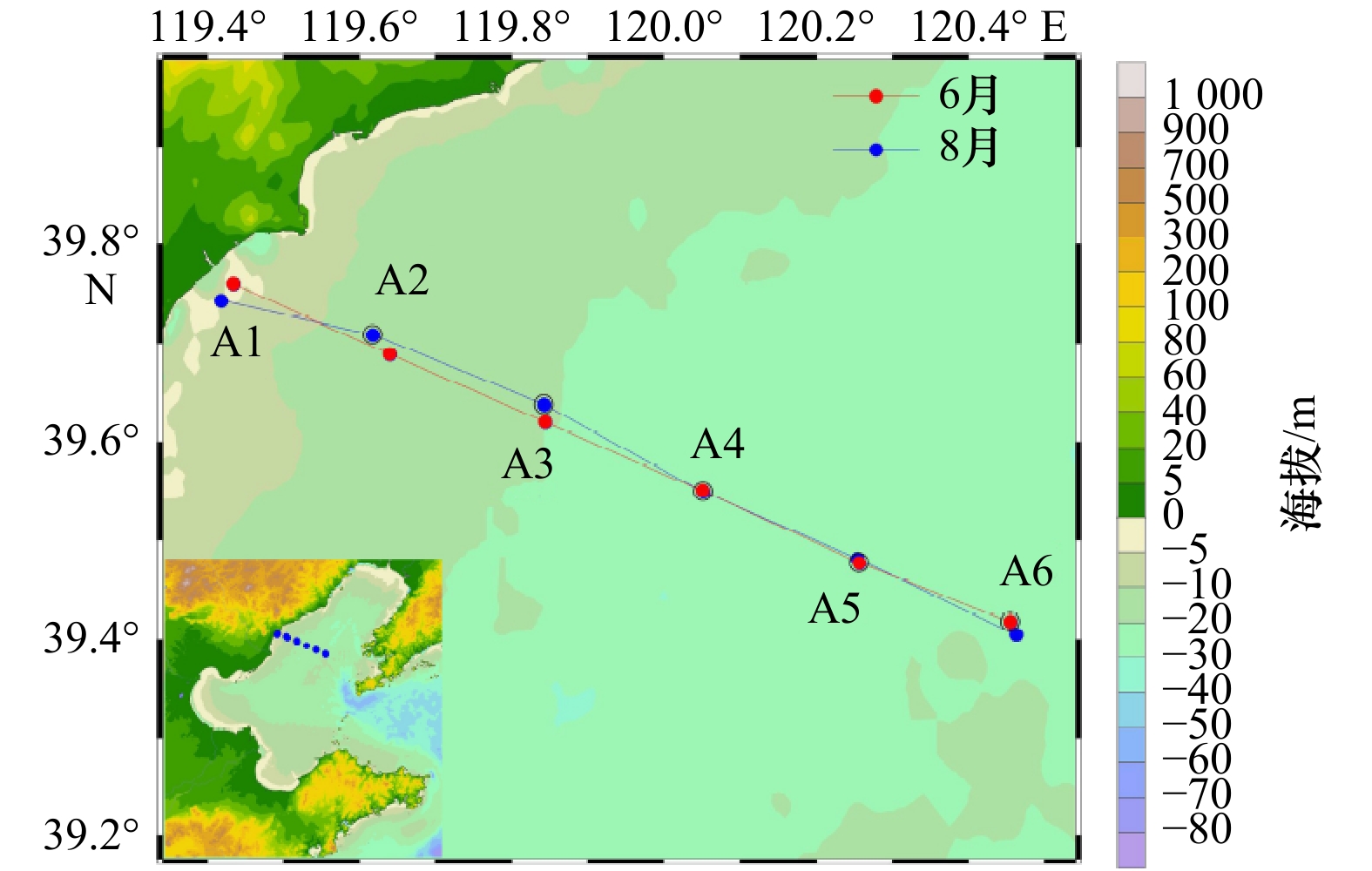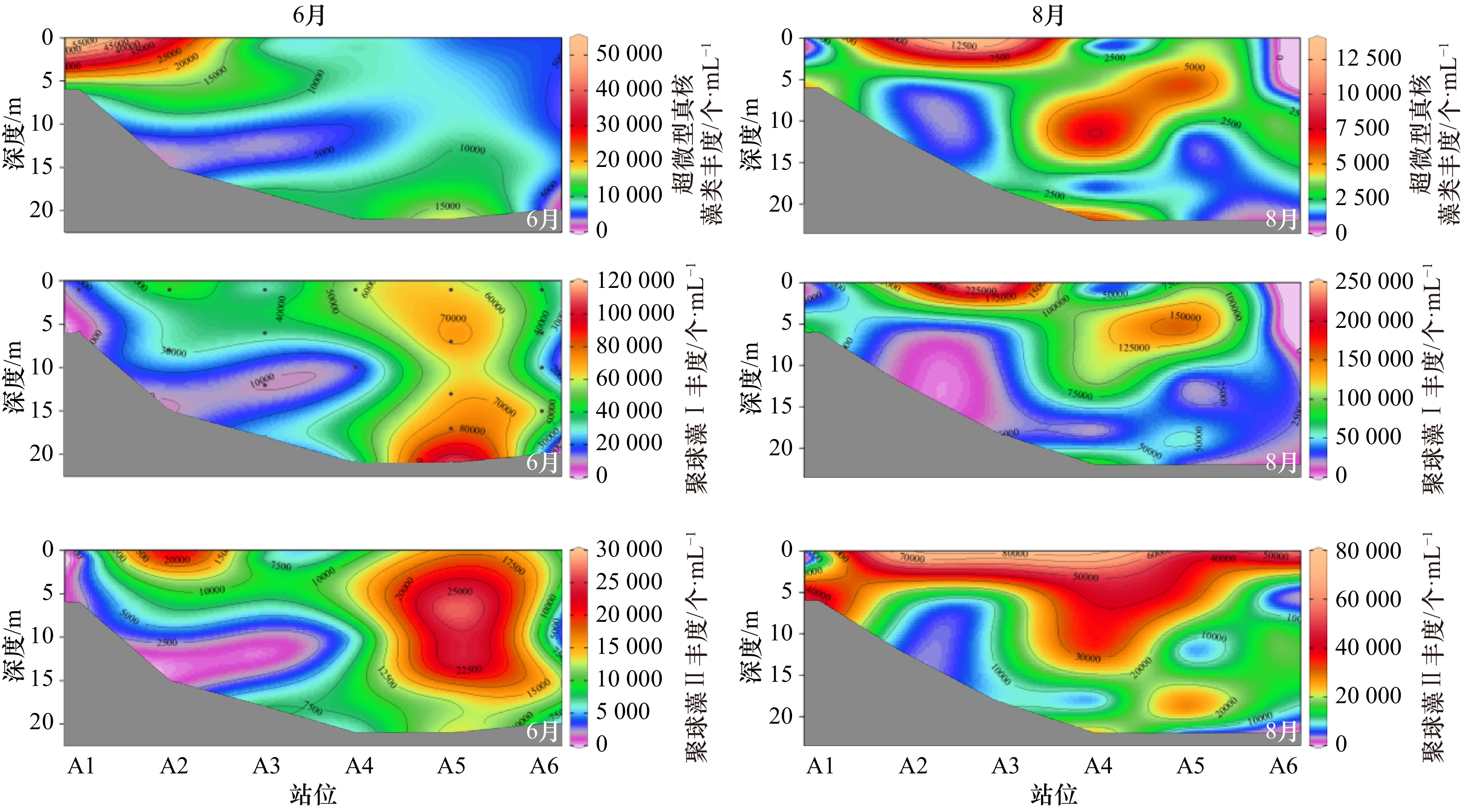Picophytoplankton from Qinhuangdao coastal waters in spring and summer
-
摘要: 2017年6月和8月,通过对秦皇岛海域的超微型浮游植物进行现场调查和流式细胞仪分析,发现了聚球藻(Synechococcus)和超微型真核藻类(picoeukaryotes)两大类群,其中聚球藻又分为聚球藻Ⅰ和聚球藻Ⅱ两个亚群。调研期间,正处于秦皇岛海域褐潮高发期。通过分析超微型浮游植物细胞丰度、碳生物量及分布特点,研究了秦皇岛海域在褐潮高发期超微型浮游植物分布及相关环境因子影响。结果表明,6月份超微型真核藻、聚球藻Ⅰ和聚球藻Ⅱ平均丰度分别为1.14×104 个/mL、4.02×104 个/mL和1.04×104 个/mL,碳生物量均值分别为27.22 μg/L、8.49 μg/L和2.27 μg/L;在8月份超微型真核藻、聚球藻Ⅰ和聚球藻Ⅱ平均丰度分别为3.27×103 个/mL、5.79×104 个/mL 和2.58×104个/mL,碳生物量均值分别为6.35 μg/L、13.41 μg/L和5.83 μg/L。超微型真核藻、聚球藻Ⅰ和聚球藻Ⅱ在6月份和8月份表现出不同的分布特征。超微型真核藻的细胞丰度从6月到8月明显降低一个数量级,说明8月份过高的水体温度与低浓度的营养物质等因素限制了超微型真核藻中褐潮种的生长。聚球藻Ⅰ和聚球藻Ⅱ细胞丰度在6月份呈现从河口到近岸逐渐升高的分布趋势,而超微型真核藻呈现下降的分布趋势。与6月份聚球藻Ⅰ和聚球藻Ⅱ细胞丰度分布相反,超微型真核藻和聚球藻Ⅰ细胞丰度则在8月份呈现从河口到近岸逐渐降低的分布趋势,而聚球藻Ⅱ细胞丰度的区域分布趋势不明显,主要分布在水体表层。通过对超微型真核藻、聚球藻Ⅰ和聚球藻Ⅱ与环境因子相关性分析表明,6月份硝酸盐与铵盐是聚球藻Ⅰ细胞生长的主要控制因子,而聚球藻Ⅱ与环境因子没有明显的相关性,超微型真核藻的细胞丰度与硅酸盐浓度呈正相关。在8月份,超微型真核藻细胞的生长受到多种环境因子(硝酸盐、亚硝酸盐、硅酸盐、磷酸盐、温度以及光照)的共同作用的影响,聚球藻Ⅰ细胞丰度与硝酸盐呈正相关,温度与光照则是影响聚球藻Ⅱ细胞分布的关键因素。Abstract: During June and August 2017, two picophytoplankton groups including Synechococcus and picoeukaryotes were found in Qinhuangdao coastal waters, and Synechococcus could be divided into two sub-groups of Synechococcus Ⅰ and Synechococcus Ⅱ. During the sampling period, it was during high-incidence period of brown tide. To investigate the effects of the related environmental factors on the spatical distributions of picophytoplankton in Qinhuangdao coastal waters, we compared their cell abundances, carbon biomass and distributional characteristics during the brown tide. The results showed that the average abundances of picoeukaryotes, Synechococcus Ⅰ and Synechococcus Ⅱ in June were 1.14×104 cell/mL, 4.02×104 cell/mL and 1.04×104 cell/mL, respectively, and the average carbon biomass were 27.22 μg/L, 8.49 μg/L and 2.27 μg/L respectively. While in August, the average abundances of picoeukaryotes, Synechococcus Ⅰ and Synechococcus Ⅱ were 3.27×103 cell/mL, 5.79×104 cell/mL and 2.58×104 cell/mL, and the average carbon biomass were 6.35 μg/L, 13.41 μg/L and 5.83 μg/L respectively. The abundance of picoeukaryotes decreased by an order of magnitude from June to August, indicating that the growth of dominant species of brown tide was limited by high temperature and low nutrients in August. Picoeukaryotes, Synechococcus Ⅰ and Synechococcus Ⅱ showed different distributions in June and August. Synechococcus Ⅰ and Synechococcus Ⅱ increased gradually from estuary to nearshore in June, while picoeukaryotes showed a downward trend. Inversely, picoeukaryotes and Synechococcus Ⅰ showed a decreasing trend from estuary to nearshore in August, and the distribution character of Synechococcus Ⅱ abundance was not obvious in Qinhuangdao coastal waters, mainly existing in surface layer. The results of correlation analysis with related environmental factors indicated that nitrate and ammonium salt were the key factor in controlling the growth of Synechococcus Ⅰ in June while picoeukaryotes was limited by the silicate concentration. There was no significant correlation between Synechococcus Ⅱ and environment factors in June. In August, the growth of picoeukaryotes was affected by a variety of environmental factors, such as nitrate, nitrite, silicate, phosphate, temperature and light while Synechococcus Ⅰ was positively correlated with nitrate. The temperature and light were the key factors affecting the Synechococcus Ⅱ distribution in August.
-
Key words:
- picophytoplankton /
- brown tide /
- environmental factors /
- Qinhuangdao
-
表 1 超微型浮游植物各站位细胞丰度(个/mL)
Tab. 1 The cell abundances (cells/mL) of picophytoplankton in each station
站位 超微型真核藻类 聚球藻Ⅰ 聚球藻Ⅱ 6月 8月 6月 8月 6月 8月 A1 3.22×104 2.76×103 8.70×103 4.94×104 1.41×103 2.58×104 A2 1.40×104 2.89×103 3.00×104 4.07×104 8.98×103 2.42×104 A3 8.38×104 3.44×103 2.35×104 5.40×104 4.75×103 1.77×104 A4 7.38×103 4.28×103 2.79×104 7.79×104 6.46×103 3.46×104 A5 9.91×103 3.11×103 7.48×104 7.76×104 2.12×104 2.30×104 A6 5.92×103 1.69×103 3.87×104 2.22×104 1.61×104 1.46×104 -
[1] Waterbury J B, Watson S W, Guillard R R L, et al. Widespread occurrence of a unicellular, marine, planktonic, cyanobacterium[J]. Nature, 1979, 277(5694): 293−294. doi: 10.1038/277293a0 [2] Chisholm S W, Olson R J, Zettler E R, et al. A novel free-living prochlorophyte abundant in the oceanic euphotic zone[J]. Nature, 1988, 334(6180): 340−343. doi: 10.1038/334340a0 [3] Li W K W, Rao D V S, Harrison W G, et al. Autotrophic picoplankton in the tropical ocean[J]. Science, 1983, 219(4582): 292−295. doi: 10.1126/science.219.4582.292 [4] Marie D, Simon N, Guillou L, et al. Flow cytometry analysis of marine picoplankton[M]//Diamond R A, Demaggio S. In Living Color. Berlin, Heidelberg: Springer, 2000. [5] Blanchot J, Rodier M. Picophytoplankton abundance and biomass in the western tropical Pacific Ocean during the 1992 El Niño year: results from flow cytometry[J]. Deep Sea Research Part I: Oceanographic Research Papers, 1996, 43(6): 877−895. doi: 10.1016/0967-0637(96)00026-X [6] Chen Bingzhang, Lei Wang, Song Shuqun, et al. Comparisons of picophytoplankton abundance, size, and fluorescence between summer and winter in northern South China Sea[J]. Continental Shelf Research, 2011, 31(14): 1527−1540. doi: 10.1016/j.csr.2011.06.018 [7] Li W K W. Primary production of prochlorophytes, cyanobacteria, and eucaryotic ultraphytoplankton: measurements from flow cytometric sorting[J]. Limnology and Oceanography, 1994, 39(1): 169−175. doi: 10.4319/lo.1994.39.1.0169 [8] Partensky F, Blanchot J, Lantoine F, et al. Vertical structure of picophytoplankton at different trophic sites of the tropical northeastern Atlantic Ocean[J]. Deep Sea Research Part I: Oceanographic Research Papers, 1996, 43(8): 1191−1213. doi: 10.1016/0967-0637(96)00056-8 [9] Blanchot J, André J M, Navarette C, et al. Picophytoplankton in the equatorial Pacific: vertical distributions in the warm pool and in the high nutrient low chlorophyll conditions[J]. Deep Sea Research Part I: Oceanographic Research Papers, 2001, 48(1): 297−314. doi: 10.1016/S0967-0637(00)00063-7 [10] 张勇, 张永丰, 张万磊, 等. 秦皇岛海域微微型藻华期间叶绿素a分级研究[J]. 生态科学, 2012, 31(4): 357−363. doi: 10.3969/j.issn.1008-8873.2012.04.003Zhang Yong, Zhang Yongfeng, Zhang Wanlei, et al. Size fraction of chlorophyll a during and after brown tide in Qinhuangdao coastal waters[J]. Ecological Science, 2012, 31(4): 357−363. doi: 10.3969/j.issn.1008-8873.2012.04.003 [11] 陈燕, 李欣阳, 张建乐. 秦皇岛近岸海域水质状况调查与评价[J]. 河北渔业, 2014(5): 15−20, 40. doi: 10.3969/j.issn.1004-6755.2014.05.006Chen Yan, Li Xinyang, Zhang Jianle. Current condition and assessment of inshore water quality in Qinhuangdao[J]. Hebei Fisheries, 2014(5): 15−20, 40. doi: 10.3969/j.issn.1004-6755.2014.05.006 [12] Bricelj V, MacQuarrie S, Schaffner R. Differential effects of Aureococcus anophagefferens isolates ("brown tide") in unialgal and mixed suspensions on bivalve feeding[J]. Marine Biology, 2001, 139(4): 605−616. doi: 10.1007/s002270100612 [13] 宋广军, 宋伦, 王年斌, 等. 褐潮研究现状[J]. 河北渔业, 2014(9): 61−66. doi: 10.3969/j.issn.1004-6755.2014.09.025Song Guangjun, Song Lun, Wang Nianbin, et al. The present research status of brown tide[J]. Hebei Fisheries, 2014(9): 61−66. doi: 10.3969/j.issn.1004-6755.2014.09.025 [14] 孙辉. 秦皇岛扇贝养殖区浮游病毒丰度及多样性的研究[D]. 青岛: 中国海洋大学, 2014.Sun Hui. Study on abundance and diversity of virioplankton in scallop farming around Qinhuangdao[D]. Qingdao: Ocean University of China, 2014. [15] 宁修仁, 沃洛D. 长江口及其毗连东海水域蓝细菌的分布和细胞特性及其环境调节[J]. 海洋学报, 1991, 13(4): 552−559.Ning Xiuren, Vogel D. The distribution and environmently regulating mechanism of the Cyanobacteria with its cell characteristic in Changjiang Estuary and its adjacent waters[J]. Haiyang Xuebao, 1991, 13(4): 552−559. [16] 杨燕辉, 焦念志. 流式细胞仪检测的胶州湾超微型浮游植物的分布和动态变化[C]//中国海洋与湖沼学会甲壳动物学分会、中国动物学会、中国海洋与湖沼学会生态学分会2000年学术研讨会论文摘要集. 青岛: 中国海洋湖沼学会, 2000.Yang Yanhui, Jiao Nianzhi. The distribution and dynamic change of picophytoplankton in Jiaozhou Gulf by flow cytometry (FCM)[C]//China Ocean and Limnetic Society Zoology Section of the Shell, China Zoological Society, Ecology Branch of China Marine and Lacustring Bog Institute in 2000 Attended the Academic Seminar on Abstract Set. Qingdao: China Society for Oceanology and Limnology, 2000. [17] 魏玉秋, 孙军, 丁昌玲. 2014年夏季南海北部超微型浮游植物分布及环境因子影响[J]. 海洋学报, 2015, 37(12): 56−65.Wei Yuqiu, Sun Jun, Ding Changling. Distribution and environmental impact factors of picoplankton in the northern South China Sea in summer 2014[J]. Haiyang Xuebao, 2015, 37(12): 56−65. [18] Dai Minhan, Wang Lifang, Guo Xianghui, et al. Nitrification and inorganic nitrogen distribution in a large perturbed river/estuarine system: the Pearl River Estuary, China[J]. Biogeosciences, 2008, 5(5): 1227−1244. doi: 10.5194/bg-5-1227-2008 [19] 郭术津, 李彦翘, 张翠霞, 等. 渤海浮游植物群落结构及与环境因子的相关性分析[J]. 海洋通报, 2014, 33(1): 95−105. doi: 10.11840/j.issn.1001-6392.2014.01.013Guo Shujin, Li Yanqiao, Zhang Cuixia, et al. Phytoplankton community in the Bohai Sea and its relationship with environmental factors[J]. Marine Science Bulletin, 2014, 33(1): 95−105. doi: 10.11840/j.issn.1001-6392.2014.01.013 [20] 刘昕, 张俊彬, 黄良民. 流式细胞仪在海洋生物学研究中的应用[J]. 海洋科学, 2007, 31(1): 92−96. doi: 10.3969/j.issn.1000-3096.2007.01.017Liu Xin, Zhang Junbin, Huang Liangmin. Applications of flow cytometry (FCM) in researches of marine biology[J]. Marine Sciences, 2007, 31(1): 92−96. doi: 10.3969/j.issn.1000-3096.2007.01.017 [21] Phinney D A, Cucci T L. Flow cytometry and phytoplankton[J]. Cytometry, 1989, 10(5): 511−521. doi: 10.1002/cyto.990100506 [22] Wei Yuqiu, Sun Jun, Zhang Xiaodong, et al. Picophytoplankton size and biomass around equatorial eastern Indian Ocean[J]. MicrobiologyOpen, 2019, 8(2): e00629. doi: 10.1002/mbo3.629 [23] 宁修仁, 蔡昱明, 李国为, 等. 南海北部微微型光合浮游生物的丰度及环境调控[J]. 海洋学报, 2003, 25(3): 83−97.Ning Xiuren, Cai Yuming, Li Guowei, et al. Photosynthetic Picoplankton in the northern South China Sea[J]. Haiyang Xuebao, 2003, 25(3): 83−97. [24] 焦念志. 海洋微型生物生态学[M]. 北京: 科学出版社, 2006.Jiao Nianzhi. Marine Picoplankton Ecology[M]. Beijing: China Science Press, 2006. [25] ter Braak C J F. Canonical correspondence analysis: a new eigenvector technique for multivariate direct gradient analysis[J]. Ecology, 1986, 67(5): 1167−1179. doi: 10.2307/1938672 [26] ter Braak C J F, Prentice I C. A theory of gradient analysis[J]. Advances in Ecological Research, 2004, 34: 235−282. doi: 10.1016/S0065-2504(03)34003-6 [27] Kong Fanzhou, Yu Rencheng, Zhang Qingchun, et al. Pigment characterization for the 2011 bloom in Qinhuangdao implicated “brown tide” events in China[J]. Chinese Journal of Oceanology and Limnology, 2012, 30(3): 361−370. doi: 10.1007/s00343-012-1239-z [28] Zhang Qingchun, Qiu Limei, Yu Rencheng, et al. Emergence of brown tides caused by Aureococcus anophagefferens Hargraves et Sieburth in China[J]. Harmful Algae, 2012, 19: 117−124. doi: 10.1016/j.hal.2012.06.007 [29] 古彬, 甄毓, 米铁柱. 秦皇岛扇贝养殖区褐潮暴发期浮游微藻群落结构特点研究[J]. 中国海洋大学学报, 2015, 45(7): 64−72.Gu Bin, Zhen Yu, Mi Tiezhu. Characterization of phytoplankton community in the coastal waters of Qinhuangdao during brown tide[J]. Periodical of Ocean University of China, 2015, 45(7): 64−72. [30] 马玉, 汪岷, 夏骏, 等. 秦皇岛褐潮期超微型浮游生物丰度及多样性研究[J]. 中国海洋大学学报, 2016, 46(6): 142−150.Ma Yu, Wang Min, Xia Jun, et al. Studies on abundance and diversity of microplankton during brown tide around Qinhuangdao area[J]. Periodical of Ocean University of China, 2016, 46(6): 142−150. [31] 于杰, 张玲玲, 孙妍, 等. 渤海海域褐潮期微型浮游生物多样性的初步研究[J]. 中国海洋大学学报, 2015, 45(3): 73−78.Yu Jie, Zhang Lingling, Sun Yan, et al. Diversity of nanoplankton during the brown tide in the Bohai Sea[J]. Periodical of Ocean University of China, 2015, 45(3): 73−78. [32] 宋伦, 吴景, 刘卫东, 等. 渤海褐潮过程生物多样性分析[C]//中国环境科学学会2016年学术年会论文集. 北京: 中国环境科学出版社, 2016.Song Lun, Wu Jing, Liu Weidong, et al. Biodiversity analysis of brown tide in the Bohai Sea[C]//2016 Annual Meeting of Chinese Society for Environmental. Beijing: China Environmental Science Press, 2016. [33] Zhang Xiaodong, Kan Jinjun, Wang Jing, et al. First record of a large-scale bloom-causing species Nannochloropsis granulata (Monodopsidaceae, Eustigmatophyceae) in China Sea waters[J]. Ecotoxicology, 2015, 24(7/8): 1430−1441. [34] 杨红生, 周毅. 滤食性贝类对养殖海区环境影响的研究进展[J]. 海洋科学, 1998, 22(2): 42−44.Yang Hongsheng, Zhou Yi. Research progress on environmental impact of filter-feeding shellfish on aquaculture areas[J]. Marine Sciences, 1998, 22(2): 42−44. [35] Gobler C J, Renaghan M J, Buck N J. Impacts of nutrients and grazing mortality on the abundance of Aureococcus anophagefferens during a New York brown tide bloom[J]. Limnology and Oceanography, 2002, 47(1): 129−141. doi: 10.4319/lo.2002.47.1.0129 [36] Sunda W G, Graneli E, Gobler C J. Positive feedback and the development and persistence of ecosystem disruptive algal blooms[J]. Journal of Phycology, 2006, 42(5): 963−974. doi: 10.1111/j.1529-8817.2006.00261.x [37] Buskey E J, Montagna P A, Amos A F, et al. Disruption of grazer populations as a contributing factor to the initiation of the Texas brown tide algal bloom[J]. Limnology and Oceanography, 1997, 42(5part2): 1215−1222. doi: 10.4319/lo.1997.42.5_part_2.1215 [38] Laroche J, Nuzzi R, Waters R, et al. Brown Tide blooms in Long Island's coastal waters linked to interannual variability in groundwater flow[J]. Global Change Biology, 2010, 3(5): 397−410. [39] 陈杨航, 梁君荣, 陈长平, 等. 褐潮—一种新型生态系统破坏性藻华[J]. 生态学杂志, 2015, 34(1): 274−281.Chen Yanghang, Liang Junrong, Chen Changping, et al. Brown tide: a new ecosystem disruptive algal bloom[J]. Chinese Journal of Ecology, 2015, 34(1): 274−281. [40] Chiang K P, Kuo M C, Chang J, et al. Spatial and temporal variation of the Synechococcus population in the East China Sea and its contribution to phytoplankton biomass[J]. Continental Shelf Research, 2002, 22(1): 3−13. [41] 张永丰, 李欣阳, 张万磊, 等. 微微型藻华爆发海域硅酸盐与叶绿素a分布特征研究[J]. 生态科学, 2013, 32(4): 509−513.Zhang Yongfeng, Li Xinyang, Zhang Wanglei, et al. Spatial and temporal distribution of silicate and chlorophyll a in the coastal waters with picophytoplankton algal bloom[J]. Ecological Science, 2013, 32(4): 509−513. [42] 焦念志, 杨燕辉. 中国海原绿球藻研究[J]. 科学通报, 2002, 47(15): 1243−1250.Jiao Nianzhi, Yang Yanhui. Ecological studies on Prochlorococcus in China Sea[J]. Chinese Science Bulletin, 2002, 47(15): 1243−1250. -





 下载:
下载:




